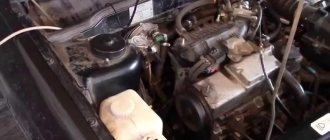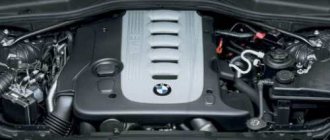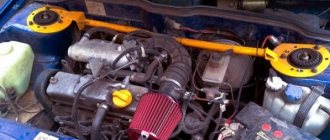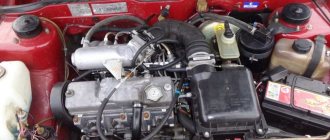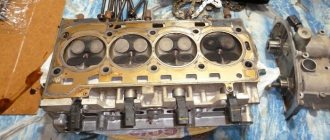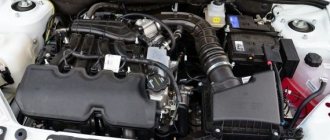As many people know, an internal combustion engine is a rather complex mechanism that needs to be regularly maintained and repaired from time to time. Otherwise, some problems may appear during operation. Drivers often feel that the engine becomes more difficult to start, its power decreases, gasoline consumption increases, unusual sounds and vibrations arise, and the engine begins to operate unstably.
You need to remember that if the engine of a VAZ 2107 is misfiring, this is a serious breakdown that needs to be fixed urgently so as not to lead to more complex problems. In this article we will discuss how the breakdown manifests itself, what the causes may be and how to eliminate them.
FIVE SIGNS OF TROUBLE
It is very important that the fault is diagnosed in a timely manner. Then you need to isolate the problem as quickly as possible so that repairs can be made.
So, if the VAZ 2107 engine has trouble with the carburetor, the reason for this may be the malfunction of one of the cylinders. Sometimes several cylinders fail at once. In fact, this is due to the fact that for some reason the working mixture does not ignite in the combustion chamber of an idle cylinder, or it does not burn completely.
We list five signs of engine tripping in a VAZ:
- At idle, the engine begins to twitch and shake. Sometimes the shaking becomes so powerful that the vibrations are felt throughout the body, transmitted to the steering wheel and even to the gear lever. With such strong vibration, we are most likely talking about a complete failure of one of the cylinders.
- The engine power noticeably disappears, the driver feels the gas pedal sink, jerks appear during acceleration, and fuel consumption increases. The check engine light may come on. Of course, these problems also appear with other malfunctions. But this is exactly how tripling manifests itself.
- The engine speed begins to float or jump. RPM fluctuations can be either minor or quite large.
- If you look at the electrodes of the spark plugs, you will notice black carbon deposits. Of course, this may indicate a malfunction of the spark plug itself. But if, after changing the spark plug set, carbon deposits appear again in the near future, then there is another reason for the breakdown.
- The exhaust system begins to operate with sound “jerks” that transmit vibration to the body.
Even if you notice only one of these symptoms, you urgently need to understand what was the source of the breakdown. The point is that equipment failures cannot be ignored. After all, delay can lead to more serious problems that will require expensive repairs.
Brief summary
Whatever the possible reason, if the engine of a VAZ 2107 does not pull, it is necessary to identify and eliminate the malfunction as quickly as possible. After all, ignoring the problem can lead to a much more serious breakdown and costly repairs.
Hello, auto mechanics! Help me solve the problem: the engine in a VAZ 2107 dies when it’s hot. I have a 2008 Seven, in good condition. Sometimes the engine runs normally, but sometimes the “Check Engine” light comes on for no reason and the engine starts to stall. My car has an injection power system. If you turn off the engine and then start it again, the problem disappears. But not for long. I want to completely get rid of the problem. Tell me where to look first.
Look at the spark plugs, the module and, as a last resort, the pump!
I looked at the spark plugs, didn’t find any carbon deposits, the pump is also working, I haven’t tinkered with the ignition module yet
There can be many reasons for this: ignition module, faulty spark plugs, clogged injectors, unadjusted valves
Thanks, I'll take a look! I hope you won't need to go for diagnostics.
Buy a BC so you don’t have to go to diagnostics for trifles.
Why does the VAZ 2107 engine stall when hot? I am familiar with this problem firsthand. In fact, there can be many reasons why the power unit of a car begins to trip, as well as ways to eliminate them. Fortunately, the injection engine of the “seven” is quite simple in design, so you can figure out this issue without qualified help. Let's look at everything in order.
REASONS FOR THE MALFUNCTION
Why does the engine in the VAZ 2107 suffer from injector problems?
If the driver observes signs of malfunction in the operation of the cylinders, it is necessary to diagnose the operation of the power unit. There are five most common reasons:
- problems with the ignition system;
- violation of the formation of the working mixture;
- malfunction of the gas distribution mechanism;
- malfunction of the power steering system;
- failure of the engine itself.
I would like to say right away that there may be many more reasons. And without high-quality diagnostics, it is not always possible to determine exactly what the problem is. But in this article we will discuss the most common faults in most cases, which in 90 percent of cases drivers can detect and fix on their own.
Reason 1: problems with the ignition system
One of the main reasons for engine stalling is a failure in setting up the ignition system. If you listen carefully to how the motor operates, you can hear popping noises accompanied by slight twitching of the motor, which indicates that one of the strokes is missed.
If these signs appear at idle, but after the crankshaft is spun, the engine becomes stable, this indicates early ignition. This means you need to adjust the ignition setting.
If everything is set up well, you can check the spark plugs. In most cases, it is faulty spark plugs that cause the engine to stall on all VAZ models. The best option is to completely replace the kit with a working one.
It is important to note that different spark plugs are suitable for different engines. For example, you need to pay attention to the heat rating and other important design features. In rare situations, when it is not possible to urgently change the spark plugs, but you have to drive, you can temporarily clean what you have and make sure that the gap is set correctly.
Often, at the same time as the spark plugs, the spark plug wires also become unusable. Therefore, they also need to be checked and, if necessary, replaced.
It happens that the engine starts to stall after rain. This may indicate problems with the explosives. To diagnose, you need to start the engine in the dark and inspect the high-voltage wires.
If a spark appears, this indicates that the insulation is broken. You can temporarily solve the problem by wrapping the sparkling area with electrical tape. But this solution is temporary until the nearest auto store!
Sometimes the car starts to jerk only after warming up. It starts and warms up reliably. This may indicate that there is a problem with the ignition coils.
Reason 2: violation of the formation of the working mixture
If the ignition system works like a clock, but the problem still remains, it’s time to pay attention to the mixture formation system. Perhaps it is not entering the cylinder. Or for some reason the fuel mixture does not want to ignite. The fact is that only at certain proportions of air and fuel does a spark lead to ignition. A lean or rich mixture will not burn. The engine begins to operate unstably when cold or warm, at idle or under load.
The problem could be quite simple: a dirty air filter. Often it is enough just to replace it with a new one, and the car begins to please its owner again.
Fuel sometimes begins to flow in excess quantities. This may indicate that the injector nozzles are starting to overflow. This means it’s time to check the operation of the entire injector.
When depressurization occurs, excess air can enter the system, which leads to a lean fuel mixture. Air congestion is also caused by the fact that the operation of the vacuum brake booster is disrupted.
Reason 3: failure of the engine itself
In order for the engine to operate stably and the working mixture to be burned as efficiently as possible, the cylinders must be well sealed during the stroke. If the operation of the cylinder-piston group or gas distribution mechanism inside the engine is damaged, this can lead to problems in the operation of the gas distribution system, which leads to partial depressurization.
If the piston rings are stuck or completely destroyed, if the piston itself is damaged, if scuffs or cracks appear on the cylinder walls, or if the valves of the gas distribution mechanism are burnt out, all this can lead to the fact that the piston simply will not be able to properly compress the combustible mixture.
To diagnose a malfunction, compression is measured in all cylinders. If the compression indicator drops in only one of them, it will be enough to pour a little oil there and take the measurement again. When the compression rises, you can judge about piston problems. If there is no change in the compression level, then the valve has burned out.
Sometimes the cause of low compression is incorrect valve adjustment. It would be a good idea to check the condition of the rocker or hydraulic compensator. A malfunction can result in the valve simply not fitting tightly to the seat.
Sometimes, to eliminate the problem, it is enough to correct the general adjustments of the gas distribution mechanism. For example, it is important to monitor the valve timing settings.
Solution methods
When the reasons for the throttling of the injection-type VAZ 2107 engine have been determined, you can proceed directly to analyzing options for eliminating the problem. Before you begin, you need to understand that you need to know the design features of the motor.
But the 2107 engine is so simple that even the most inexperienced motorist will figure out what’s going on. So, let's look at how to remove the injector tripping of a VAZ 2107 engine.
Fuel pump and filter
The first place to look for the cause begins with the fuel supply. First, you should check the fuel pump for functionality and whether there are any malfunctions. If this element does not show visible signs of damage, then it is recommended to disassemble it and check it.
Many experienced car enthusiasts advise, after the fuel pump, to start replacing the fuel filter element, since this is where fuel can poorly pass to the injectors. The fuel filter, according to the service documentation, must be changed every 30-35 thousand kilometers.
Injectors
The next place to look for trouble is the injectors themselves. They may be clogged due to the use of low-quality fuel or defective due to their service life, in other words, worn out.
The elements are checked using a special stand, which not only diagnoses the condition, but also cleans the elements. If there is a damaged or worn part, it is better to replace it with a new element.
Spark plugs and high voltage wires
Loss of spark can also lead to engine malfunction. The next unit that needs to be examined is the ignition. First of all, it is recommended to diagnose the spark plugs. To do this, you need to pull them out from the block head and visually inspect them for cracks. Next, it is recommended to clean the spark plugs from accumulated dirt.
It is worth noting that it is necessary to pay attention to the condition of the spark plug contacts. If they are in oil or have heat, then the problem is not only the engine tripping.
The next stage of diagnosis is to ring the contacts using a multimeter and measure the gap. In most cases, such diagnostics show that the spark plugs are not suitable for further use and should be replaced.
Another element of the ignition system that directly affects the ignition of the air-fuel mixture is high-voltage wires. How well and economically the motor will work will depend on their condition. Therefore, it is recommended to inspect them for damage and also test them with a multimeter.
Air filter
A dirty air filter can lead to the engine not receiving enough air into the combustion chamber, and accordingly the formation of the air-fuel mixture will be disrupted. Therefore, it is recommended to inspect the element, and if it is found that it is dirty, it must be replaced.
Throttle
A dirty throttle valve also prevents the normal flow of air into the engine. To diagnose the unit, it is necessary to dismantle it. If you find that dust and other foreign objects have accumulated on the walls, you should clean the part. To do this, you will need a special product or liquid for cleaning carburetors. This operation can be performed by any car enthusiast without any problems.
valves
Burnt-out valves can cause the engine to start to misfire, since a gap is formed between the seat and the exhaust valve, through which exhaust gases flow back into the combustion chamber, thereby disturbing the balance in the air-fuel mixture.
To diagnose the unit, it is necessary to dismantle the block head. Often, already burnt-out valves are the first sign of wear on the piston group, and accordingly everything leads to a major overhaul.
ECU and sensors
The last place to look for a problem is the sensors. Thus, failure of one or more measuring elements can cause a tripping effect. Therefore, the motorist will have to check them manually, since the electronic control unit cannot always recognize that the sensor has failed.
The electronic engine control unit can also cause tripping. Accumulated errors or damage in the software will disrupt the operation of the entire system. To diagnose and troubleshoot the problem, it is recommended to contact specialists.
Why did the engine start to stall? – The most complete analysis of the reasons
What does the term “Engine Troit” mean? I ask this question at the beginning of the article in order to cut off the “couch experts”, and only real car enthusiasts who love and appreciate their car remain here.
Just one of the commentators began to assert:
“Engine tripping is when there is no one cycle in the operation of an internal combustion engine. That is, out of four cycles of engine operation, one cycle was thrown away.”
I explained to him that he was wrong, but he didn’t get it. To prevent such armchair army specialists from wasting their time and “cracking” in the comments, I want to cut them off right away.
Why the car engine started to misfire - the most common reasons
Now let's continue the conversation with real car lovers.
Today we will look at the main reasons why the motor may trip. They may seem banal, but read my work to the end carefully, I am sure you will learn something new for yourself.
What to do if the VAZ engine does not pull?
Probably, any driver has encountered such a problem when the car has lost its former dynamics: it takes a long time to accelerate, and when climbing, it completely refuses to move in higher gears. In this article we will tell you in detail what to do if the VAZ engine does not pull or pulls poorly, we will look at the main causes and troubleshooting methods.
Conventionally, all types of gasoline engines can be divided into gasoline and injection. In general, their principle of operation is absolutely the same, but the factors that affect engine power become different. Let's consider the problem of carburetor and injection engines separately.
Reason one - spark plugs
I wrote in detail about how to determine faults in car systems using spark plugs here .
I recommend reading it - it turned out to be useful, judging by your reviews, thank you.
We unscrew the spark plugs one at a time and look at their insulator. If it is covered with dense carbon deposits, then it is difficult for a spark to penetrate it. The current seeks the path with the least resistance, so the spark will not be between the electrodes, but will “go” along the insulator to the side. Its energy will not be enough to set fire to the air-fuel mixture. This cylinder will not work.
Heavy carbon deposits on the spark plug electrodes may cause the engine to trip.
We inspect the external condition of the spark plug insulator. If there are microcracks, then part of the current will not be converted into a discharge, but will escape through these damages. You need to look at the internal insulator, which is screwed into the cylinder head, and at the external one, onto which the armor wire cap is placed.
Any chips or damage can lead to poor sparking or its complete absence.
A superficial breakdown of the spark plug insulator is one of the reasons why the engine began to fail.
A large or small gap between the electrodes. Many people have heard or know that for certain engines, ignition systems and types of fuel used, spark plugs with a certain gap are required. Usually its value is indicated by the manufacturer of engines and cars.
In order for the spark plug to work well and the engine not to stall, a certain gap between its electrodes is needed
How to check the spark without special devices on the engine
This is an old, “grandfather” method, some people are afraid of it:
- They unscrewed the spark plug;
- They put an armored wire on her;
- They leaned it with the inner body, the metal part, against the engine;
- Turn on the ignition and turn the starter.
Be sure to hold on to the rubber cap of the armored wire, otherwise your hand will shake violently. This is what many are afraid of
